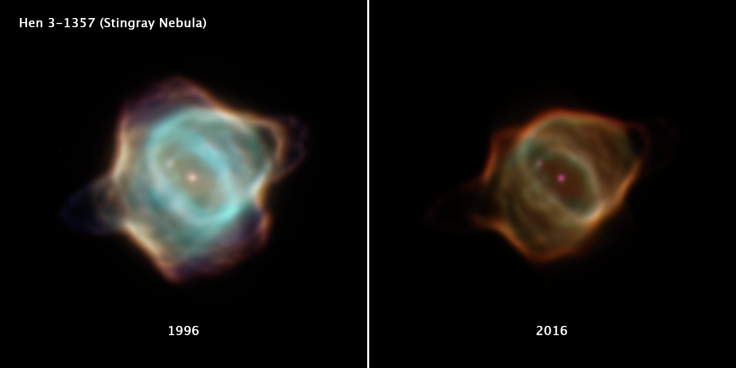NASA Hubble Captures 'Very Dramatic' Fading Of Stingray Nebula: 'We Haven't Seen That Before'
KEY POINTS
- The Hubble's 2016 photo of the Stingray Nebula shows massive changes from its appearance in 1996
- The "dramatic" and "weird" changes have been attributed to a central star inside the nebula
- The star is believed to have experienced a rapid rise in heat followed by a cooling phase
The wavy edges and the bright blue tendrils that earned the Stingray Nebula its aquatic-themed name have all but disappeared, and it's a change no one saw coming.
After analyzing a snapshot of the Stingray Nebula NASA's Hubble Space Telescope took in 2016, astronomers found that the magnificent-colored nebula has drastically changed since 1996 when it still boasted bright blue colors and a very distinguishable shape.
When the old and new photos are placed side-by-side, it can be seen that the nebula, officially called Hen 3-1357, has dimmed significantly and no longer pops out of the black velvet background of the universe.
“This is very, very dramatic, and very weird,” team member Martín A. Guerrero of the Instituto de Astrofísica de Andalucía in Granada, Spain, said in a statement on the Hubble website. “What we’re witnessing is a nebula’s evolution in real time. In a span of years, we see variations in the nebula. We have not seen that before with the clarity we get with this view.”
The oxygen emission in the Stingray Nebula dropped in brightness by a factor of nearly 1,000 between the years 1996 and 2016, researchers said. Astronomers also found unprecedented changes in the light emitted by glowing nitrogen, hydrogen and oxygen being blasted off by the dying star at the center of the nebula, according to a NASA article.

“Changes in nebulae have been seen before, but what we have here are changes in the fundamental structure of the nebula,” said the leader of the new research Bruce Balick of the University of Washington, Seattle.
“In most studies, the nebula usually gets bigger. Here, it’s fundamentally changing its shape and getting fainter, and doing so on an unprecedented time scale. Moreover, to our surprise, it’s not growing any larger. Indeed, the once-bright inner elliptical ring seems to be shrinking as it fades," he added.
The researchers studying the Stingray Nebula noted that the change in brightness is due to a response in its central star, SAO 244567. The central star has been expanding due to a temperature drop, thus emitting less ionizing radiation.
It is not yet certain at this time what’s in store for the young nebula in the future. However, astronomers believe that based on the current rate of its fading, the Stingray Nebula, which is 18,260 light-years away from Earth, may barely be detectable in 20 or 30 years.
Meanwhile, the Hubble Twitter account used the 1996 and 2016 images of the nebula in its own take of the "How it started/How it's going" meme.
How it started / How it's going pic.twitter.com/084qoxvLNl
— Hubble (@NASAHubble) December 3, 2020
© Copyright IBTimes 2024. All rights reserved.





















